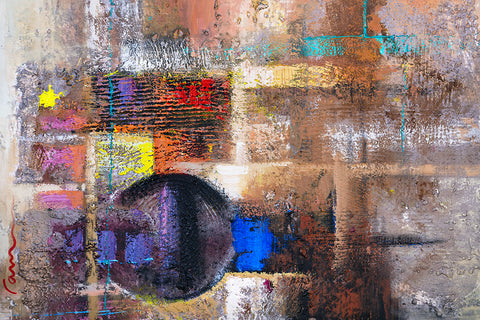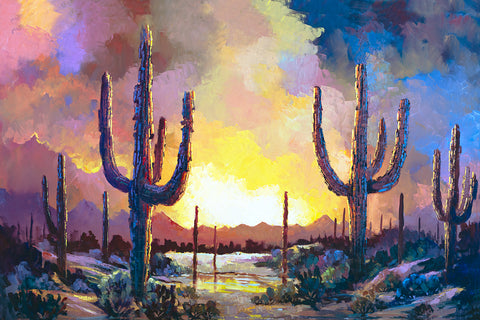Art is a timeless and universal human expression that captures the essence of our thoughts, feelings, and experiences. The world of art keeps evolving, as do the forms of art.
With eight different forms of art emerging through the ages, there's no doubt that the world will witness many more to come. Wondering what the eight forms of art are? That is exactly what we are here to talk about today.
Today, we’ll discuss different forms of art and how they’ve changed our intellectual world. The main purpose behind discussing each art form is to allow ourselves to enjoy art more deeply.

Painting
We started with the most common and undoubtedly the most critical form of art—painting! A painting is a visual representation of your creativity, imagination, thoughts, and observations.
From timeless classics to contemporary modern art, paintings have always touched our hearts and inspired us. We, as viewers, can often relate to the paintings we see. We often try to relate it to our own thoughts and imaginations.

We've seen many famous artists create magic with different types of painting styles. They use brushstrokes, vivid colors, patterns, and designs to express culture, traditions, wildlife, nature, history, and emotions. Some artists consider painting a form of therapy or an escape from the real world.

What a lot of people don't know yet is that, with advanced technology, artists can now create digital paintings as well. Digital painting and digital art platforms have improved artists' opportunities to experiment with new methods and reach a wider worldwide audience.
Sculpture
Sculpture is the definition of variety in art. It's a captivating and widely popular form of art where you get to see the most unique creations by artists. A sculpture is a three-dimensional art created with four basic methods: carving, modeling, casting, or constructing. You can use wood, metal, stone, or clay to mold into sculptures of any shape.
Sculptors carve these sculptures mostly with their hands, using the necessary tools to bring their ideas to life. Just imagine for a minute; they literally turn a raw material into beauty with their skills and creativity.
We often come across sculptures in public places. Sculptures are becoming a part of the landscape and adding art to our daily lives. Think about those impressive statues of historical figures, memorial monuments, or modern art installations.
Sculptures definitely leave a lasting impression, sparking curiosity to explore more about them!
Types Of Sculptures
- Assembled Sculptures: Nowadays, artists create more assembled sculptures using various materials, especially for abstract works, allowing them to use meaningful pieces to achieve a desired outcome.
- Cast Sculptures: In cast sculpting, casting is widely used and originated from ancient art forms like clay and bronze sculptures, where artists create a mold to shape and cover it with cast materials for durability and longevity.
- Subtraction Sculpture: Subtractive sculpture is like carving a sculpture out of a single block of material until it looks the way the artist wants, often using stone or other materials.
- Carved Sculptures: Carved sculptures were the earliest form of art used by ancient societies to depict creatures, nature, and religious figures for ceremonial purposes.
- Additive Sculpture: Additive sculpture is a different type of sculpting where the artist builds the form by adding materials instead of removing them from the original medium.

Photography
If we say that action speaks louder than words than picture speaks even louder.
One of the most fascinating forms of art is photography. It's literally about capturing precious moments and emotions through the lens of a camera and preserving them for a lifetime. Words can never express what a photograph easily can. Photorealism is one of the 7 most popular painting styles.
Photos may evoke strong emotions and take you to another place or time. You may look at a beautiful scene and feel as if you're really there, or you can look at a photograph of someone and experience their feelings. It's almost as if you're looking through a window into someone else's life.
Photographers, in particular, have a unique perspective or you can say a special eye for technical elements like perfect lighting, accurate angles, desired background, and composition to make their photographs stand out. It means "drawing with light," as in painting with light and colors, but instead of a brush, they use lenses.

Music
Next, let us discuss one of the most well-liked forms of art: music. It's similar to painting and sculpting, except that instead of colors or clay, musicians make attractive sounds that tickle our ears and touch our hearts.
From catchy pop songs to soothing classical melodies, you must have heard it all! It's thrilling to realize that music has the power to evoke emotions like happiness, sadness, excitement, or even a sense of calm. Music can literally transfer you from one place or mood to another without actually having to move physically.
There are different instruments on which you can produce music like drums, guitars, pianos, flutes, saxophones, etc. Don't we all start to form deeper connections with music that strikes our emotions and resonates with us.
Music not only makes us happy, but it also brings people together. We visit concerts or music festivals: these are large gatherings where everyone experiences the same excitement and enthusiasm via music.

Drawing
Moving on to our 5th form of art, drawing. We can draw any line or shape using a pencil, pen, or crayon. You can literally draw magic on a blank piece of paper with your skills, creativity, and innovation.
When people draw portraits of humans and objects, it’s called sketching. Ever wondered what the 3 main categories of sketching are? Fashion, industrial, and interior. Some draw cartoons, while others draw nature. There are many types of drawings with endless versatility and expression.
Remember those lovely paintings you see in museums? Those artists start with drawings as their base. Drawing allows them to plan and rehearse before applying paint to the canvas. It's similar to the plan for a masterpiece.
Type Of Drawing
- Perspective Drawing: If you've heard of 3D or anamorphic drawing, that is perspective drawing. The artist creates 3-dimensional images in a 2-dimensional space such as paper.
- Scratchboard Drawing: Drawing on a cardboard sheet covered in a thin layer of clay and India ink is known as "scratchboard drawing," according to some people.
- Silhouette Drawing: It is a drawing of an object outlined in a single shade or tone. Artists prefer drawing them in black or white.
- Line Drawing: When the artist draws straight lines and contours without shading. Line drawing refers to when artists draw an entire object without moving the instrument from the surface.
- Gesture Drawing: When artists use real-life subjects as inspiration and draw real movements, poses, forms, and expressions,
- Figure Drawing: It refers to when the artist observes the physical world's surroundings and human models and draws them on canvas.
- Cartoon Drawing: It refers to drawing comic and fictional characters with colors and shapes.

Cinema
Let us talk about cinema, one of the most distinctive forms of art, now. We know we don't have to explain cinema in detail, as everyone, including the kids, is familiar with it. Do you remember the movies you used to watch on your TV or the big screen? Well, that's cinema! It's like storytelling with moving pictures and sound.
Cinema is known to depict a fictional story with fictional characters to entertain the audience. Those movies are filled with adventure, thrills, laughter, suspense, and hilarious comedy. It's all about creating powerful experiences through the magic of movies.
Filmmakers can show you anything from any time period of history, and it's a great way to visually time travel. We don't even realize that we spend a minimum of 2 hours with a bag full of popcorn in the cinema with friends and family. This is a never-ending craze among humans.

Theater
Theater is now next on our list, which makes it a prominent form of art. You know those live stage shows you see? That's what theater is all about! It's similar to a compelling play in which performers act out storylines in front of your eyes. You’ll find many art form examples for theater.
Theater is mostly live performances where different fictional actors present a story in a cinematic way. The stage is just like a blank canvas, where instead of painters, the artists make the magic happen!
If you want to know what is common art, it’s theater!
 Literature
Literature
People are always searching for how can art change people's lives. Well, literature sure can!
Literature is one of the finest types of art! Do you know how you read books, poetry, and stories? That is, after all, literature! It's like painting images with words and going on a journey with your imagination.
Literature caters to every mood. Be it heartfelt romance, fantasy adventure, thrilling mystery, or crime suspense, literature has something for everyone.
What we personally like the most about this form of art is that literature is timeless. You can read the classic books written centuries ago and still connect with it today.

FAQs
What are the main forms of art?
Painting, sculpture, architecture, literature, music, film, and theater are the seven primary genres of art.
What is the most known type of art?
For good reason, Pop Art is one of the most well-known and well-loved art forms in history.
Why is form important in art?
Form is an essential aspect of art because it may be utilized to create depth and perspective illusions, enhance composition via contrast, and portray objects or people with realistic details. Form may also be employed in artwork to elicit emotion, convey tales, and create a feeling of movement.
How can art change people's lives'?
Art changes our lives for the better by giving us meaning to understand this world. There's no doubt that art can change our mood and how we feel about certain things. It automatically opens up our minds to millions of new ideas.
Key Takeaway
In conclusion, we’ve done our best to explain the 8 forms of art. These art forms depict human creativity and innovation. Each form has the ability to inspire, connect, and challenge us in different ways. Be it painting to sculpture, dance to literature, music to film, art keeps pushing the boundaries and enriching our lives overall.
Accepting art in all of its forms helps us to celebrate our common human experience while also appreciating the limitless possibilities of human creativity.
